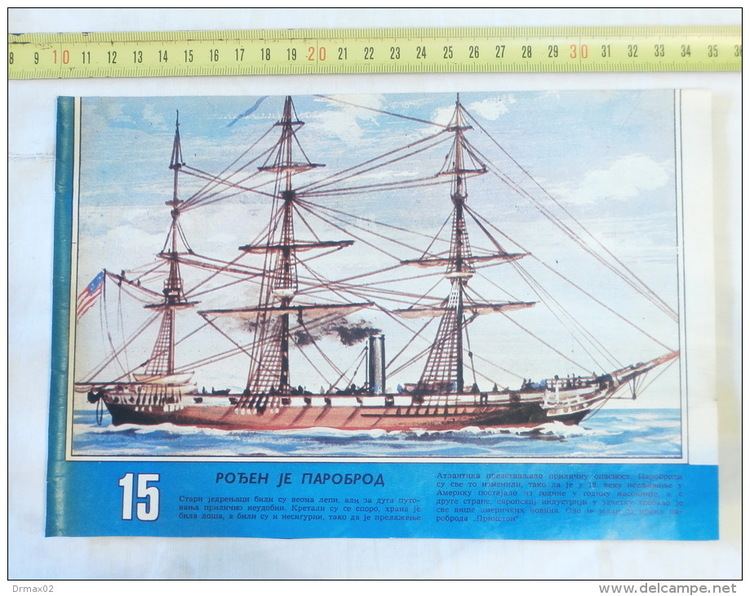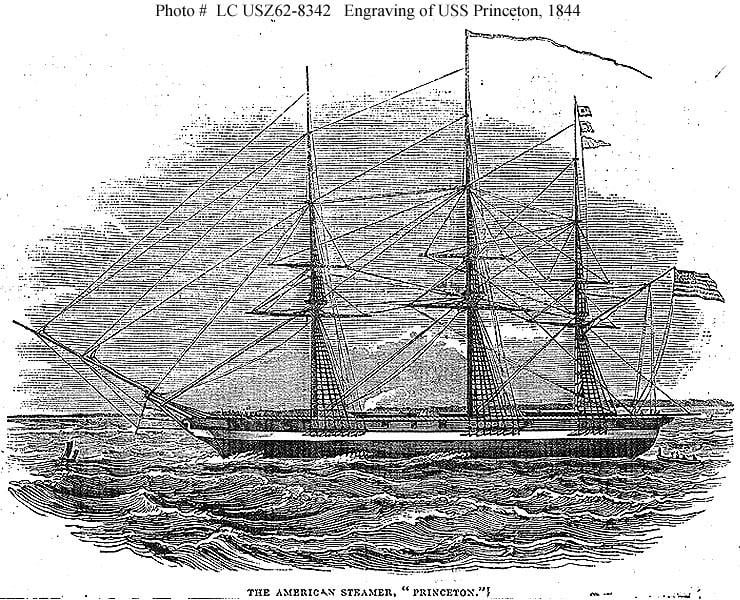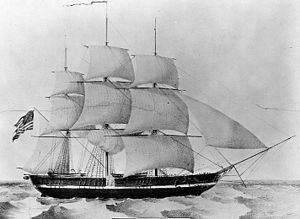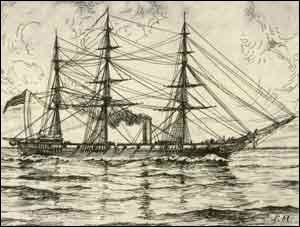Laid down October 20, 1842 Construction started 20 October 1842 Length 50 m | Ordered November 18, 1841 Commissioned September 9, 1843 Launched 5 September 1843 | |
 | ||
Fate Broken up, October 1849 | ||
The first USS Princeton was a screw steam warship in the United States Navy. Commanded by Captain Robert F. Stockton, Princeton was launched on September 5, 1843.
Contents

The ship's reputation in the Navy never recovered from a devastating incident early in her service. On February 28, 1844, during a Potomac River pleasure cruise for dignitaries that included a demonstration of her two heavy guns, one gun exploded killing six people, including Secretary of State Abel P. Upshur, Secretary of the Navy Thomas Walker Gilmer, and other high-ranking federal officials. President John Tyler, who was aboard but below decks, was not injured.

Early history

Princeton was laid down on October 20, 1842, at the Philadelphia Navy Yard as a 700 long tons (710 t) corvette. The designer of the ship and main supervisor of construction was the Swedish inventor John Ericsson, who later designed the USS Monitor. The construction was partly supervised by Captain Stockton who had secured the political support for the construction of the ship. The ship was named after Princeton, New Jersey, site of an American victory in the Revolutionary War and hometown of the prominent Stockton family. The ship was christened with a bottle of American whiskey and launched on September 5, 1843. It was ordered commissioned on September 9, 1843, with Captain Stockton in command.

Princeton made a trial trip in the Delaware River on October 12, 1843. She departed Philadelphia on October 17 for a sea trial, proceeded to New York, where she engaged in a speed contest with the British steamer SS Great Western, besting her handily, and thence returned to Philadelphia on October 20 to finish outfitting. On November 22, Captain Stockton reported "Princeton will be ready for sea in a week." On November 28, he dressed ship and received visitors on board for inspection. On November 30, she towed the USS Raritan down the Delaware and later returned to the Philadelphia Navy Yard. Princeton sailed on January 1, 1844, for New York, where she received her two big guns, named Peacemaker and Oregon. Princeton was sent to Washington, D.C. in late January, arriving on February 13. Washingtonians displayed great interest in the ship and her guns. She made trial trips with passengers on board down the Potomac River on February 16, 18 and 20, during which the Peacemaker was fired several times. After several test runs, the Princeton was considered ready.
The machinery

Princeton included the very first screw propellers powered by an engine mounted entirely below the waterline to avoid the vulnerability of paddle wheels and higher engines to gunfire. Her two vibrating lever engines were built by Merrick & Towne, and designed by Ericsson. They burned hard coal and drove a six-bladed screw 14 ft (4.3 m) in diameter. The engine was small enough to be below the waterline. Ericsson also designed the ship's collapsible funnel, an improved range-finder, and recoil systems for the main guns.
The guns
Twelve 42-pound (19 kg) carronades were mounted within the ship's iron hull. Ericsson had designed the ship to mount one long gun, named the Oregon, built in England using modern technology to fire 225-pound (102 kg) 12 in (300 mm) diameter shot. Captain Stockton wanted his ship to carry two long guns and had the second, named Peacemaker, built in Philadelphia. The two guns fired identical shot, but the Peacemaker was built with older forging technology creating a larger gun of more impressive appearance, but lower strength. Both guns were mounted onto the Princeton. Though the Oregon had undergone intensive testing and had been reinforced to prevent cracks detrimental to the integrity of the cannon, Stockton rushed the Peacemaker and mounted it without much testing. According to Kilner, the Peacemaker was "fired only five times before certifying it as accurate and fully proofed."
The Oregon, originally named The Orator, was a smooth bore muzzle loader (ML) made out of wrought iron and was capable of firing a shot 5 mi (8.0 km) using a 50 lb (23 kg) charge. It was manufactured at the Mersey Iron Works in Liverpool, England, and shipped to the U.S. in 1841. The design was revolutionary in that it used the "built-up construction" of placing red-hot iron hoops around the breech-end of the weapon, which pre-tensioned the gun and greatly increased the charge the breech could withstand.
The Peacemaker was another 12 in (300 mm) muzzle loader made by Hogg and DeLamater of New York City, under the designs and direction of Captain Stockton. Attempting to copy the Oregon, but not understanding the importance of Ericsson's hoop construction, Stockton instead heavily reinforced it at the breech simply by making the metal of the gun thicker, ending up with a weight of more than 27,000 lb (12,000 kg). This produced a gun that had the typical weakness of a wrought iron gun, the breech being unable to withstand the transverse forces of the charge. This meant it was almost certain to burst at some point.
1844 Peacemaker accident
On February 28, 1844, USS Princeton departed Alexandria, Virginia, on a pleasure and demonstration cruise down the Potomac with President John Tyler, members of his Cabinet, former First Lady Dolley Madison, Senator Thomas Hart Benton of Missouri, and approximately four hundred guests on board. Captain Stockton decided to fire the larger of her two long guns, Peacemaker, to impress his guests. Peacemaker was fired three times on the trip downriver and was loaded to fire a salute to George Washington as the ship passed Mount Vernon on the return trip. The guests aboard viewed the first set of firings and then retired below decks for lunch and refreshments.
Secretary Gilmer urged those aboard to view a final shot with the Peacemaker. When Captain Stockton pulled the firing lanyard, the gun burst. Its left side had failed, spraying hot metal across the deck and shrapnel into the crowd. Instantly killed were Navy Secretary Gilmer; Secretary of State Upshur; Captain Beverley Kennon, who was Chief of the Bureau of Construction, Equipment and Repairs; Virgil Maxcy, a Maryland attorney with decades of experience as a state and federal officeholder; David Gardiner, a New York lawyer and politician; and the President's valet, a black slave named Armistead. Several members of the gun crew were injured, but all survived. Another twenty people were injured, including Captain Stockton. The President was below decks and not injured.
Aftermath
Rather than ascribe responsibility for the explosion to individuals, Tyler wrote to Congress the next day that the disaster "must be set down as one of the casualties which, to a greater or lesser degree, attend upon every service, and which are invariably incident to the temporal affairs of mankind". He said it should not be allowed to impact their positive assessment of Stockton and his improvements in ship construction.
Plans to construct more ships modeled on the Princeton were promptly scrapped, but Tyler won Congressional approval for the construction of a single gun on the dimensions of the Peacemaker, which was fired once and never mounted. A Court of Inquiry investigated the cause of the explosion and found that all those involved had taken appropriate precautions. At Stockton's request, the Committee on Science and Arts of the Franklin Institute conducted its own inquiry, which criticized many details of the manufacturing process, as well as the use of welded band for reinforcement rather than the shrinking technique used on the Oregon. Ericsson, whom Stockton had originally paid $1,150 for designing and outfitting the Princeton, sought another $15,000 for his additional efforts and expertise. He sued Stockton for payment and won in court, but the funds were never appropriated. Stockton went on to serve as Military Governor of California and a United States Senator from New Jersey. Ericsson had a distinguished career in naval design and is best known for his work on the USS Monitor, the U.S. Navy's first ironclad warship.
To succeed Gilmer as Secretary of the Navy, Tyler appointed John Y. Mason, another Virginian. As his new Secretary of State, Tyler named John C. Calhoun of South Carolina, like his predecessor an advocate of states rights, nullification, the annexation of Texas, and its admission into the union as a slave state. But where Gilmer and Upshur had supported annexation as a national cause, Calhoun recast the political discussion. To Tyler's frustration, he promoted the annexation of Texas while "directly, unambiguously, and full-throatedly celebrating slavery and celebrating sectional advantage", that is, the importance of Texas to the longterm survival of slavery in the United States.
Julia Gardiner, who was below deck on the Princeton when her father David died in the Peacemaker explosion, became First Lady of the United States four months later. She had declined President Tyler's marriage proposal a year earlier, and sometime in 1843 they agreed they would marry but set no date. The President had lost his first wife in September 1842, and at the time of the explosion he was almost 54. Julia was not yet 24. She later explained that her father's death changed her feelings for the President: "After I lost my father I felt differently toward the President. He seemed to fill the place and to be more agreeable in every way than any younger man ever was or could be." Because he had been widowed less than two years and her father had died so recently, they married in the presence of just a few family members in New York City on June 26, 1844. A public announcement followed the ceremony. They had seven children before Tyler died in 1862, and his wife never remarried. In 1888, Julia Gardiner told journalist Nelly Bly that at the moment of the Peacemaker explosion "I fainted and did not revive until someone was carrying me off the boat, and I struggled so that I almost knocked us both off the gangplank". She said she later learned that President Tyler was her rescuer. Some historians question her account.
The Peacemaker disaster prompted a reexamination of the process used to manufacture cannons. This led to the development of new techniques that produced cannons that were stronger and more structurally sound, such as the system pioneered by Thomas Rodman.
Later history
During construction and in the years following, Stockton attempted to claim complete credit for the design and construction of Princeton.
Princeton was employed with the Home Squadron from 1845 to 1847. She later served in the Mediterranean from August 17, 1847, to June 24, 1849. Upon her return from Europe, she was surveyed and found to be in need of 68,000 dollars ($1.96 million in present-day terms) in repairs to return her to complete order. The price was deemed unacceptable and a second survey was ordered. She was condemned due to her decaying timber and broken up at the Boston Navy Yard that October and November.
Legacy
In 1851, her "Ericsson semi-cylinder" design engines, and some usable timbers, were incorporated in the construction of the second Princeton.
The Oregon is on display inside the main gate of the United States Naval Academy in Anapolis, Maryland.
The ship's bell was displayed during the 1907 Jamestown Exposition. It was later installed in the porch of Princeton University's Thomson Hall, which was constructed as a private residence in 1825 by Robert Stockton's father Richard. It is currently on outside display at the Princeton Battle Monument, near Princeton's borough hall.
